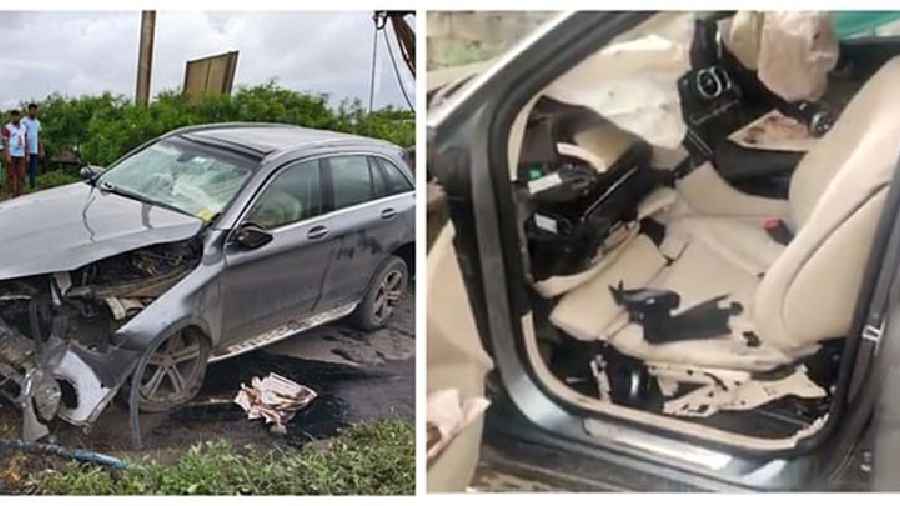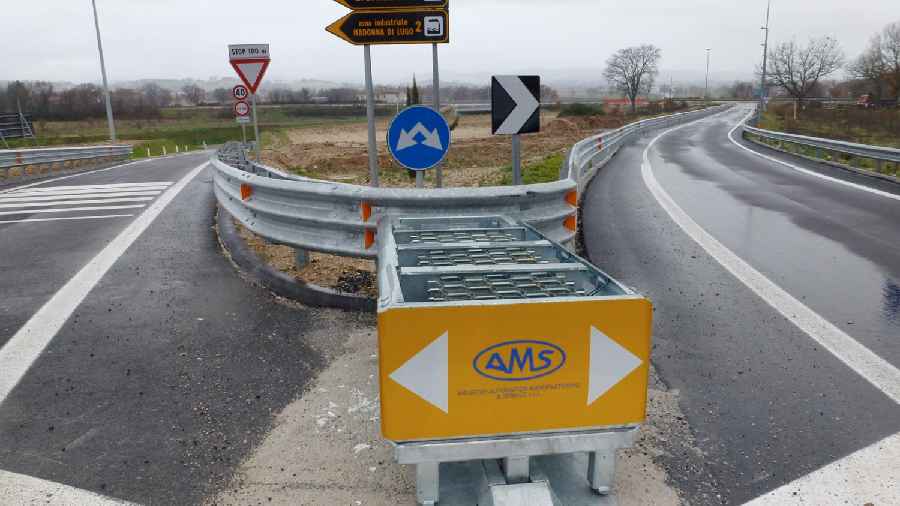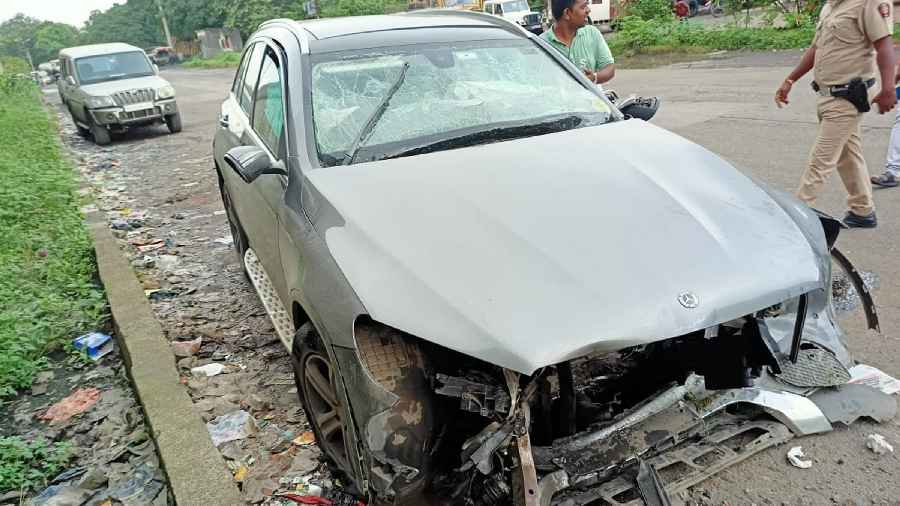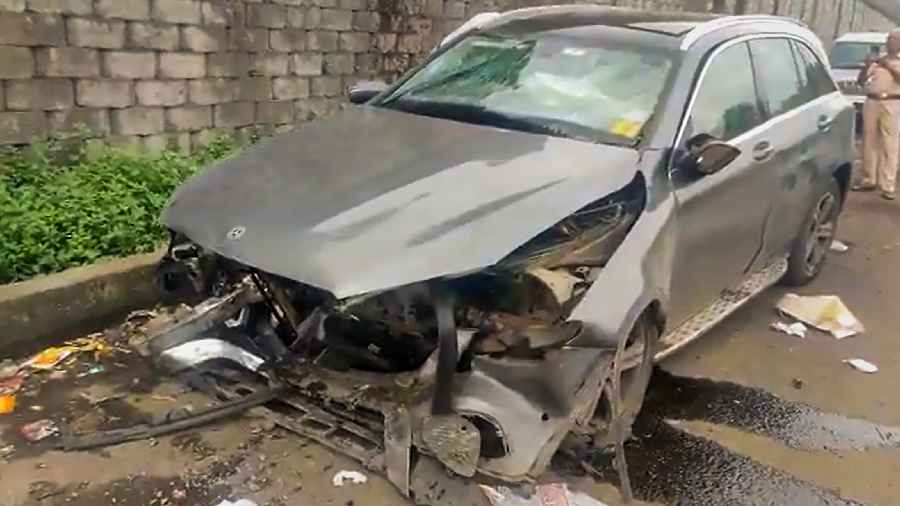The car crash that killed former Tata Sons chairman, Cyrus Mistry, and Director of Global Strategy Group at KPMG’s London office, Jehangir Pandole, would be classified as a “high- severity frontal collision”, a US-based expert who has spent decades analysing road accidents, has said, his preliminary conclusion based on photographs and initial findings of Mercedes Benz, the maker of the SUV in which the decedents were travelling.
According to the police, the SUV had four occupants. Anahita Pandole, who was at the wheel, and her husband, Darius Pandole, seated beside her were wearing seat belts. Both have suffered multiple injuries and are on external support systems. The two rear-seat occupants, Cyrus and Jehangir, were not belted. The SUV slammed into a divider on Charkoti Bridge near Palghar, around 120km from Mumbai, in Maharashtra on Sunday, September 4, 2022.
“The Mercedes event data recorder (or ‘black box’) report apparently indicates the SUV was travelling at 100 kmph five seconds before impact, adding that the speed came down to 89 kmph as the brakes were applied. So, with the SUV travelling at nearly 90 kmph into a barrier, this clearly would be categorized as a high-severity accident,” says Rajeev Kelkar, Ph.D., a founding partner at InSciTech, a scientific and engineering consulting company in the San Fransisco Bay area.
This also means, as Kelkar adds, that “heavy braking” if it occurred was applied only for a fraction (approximately 4/10th) of a second before impact. “Which suggests that perception of the hazard occurred just under 2 seconds before impact, assuming a perception-reaction time of approximately 1.5 seconds” he says.
Over the last few days, The Telegraph Online shared photographs and media reports with Kelkar to understand the Palghar accident that has renewed focus on safety on India’s roads and the use of seat belts which is yet to be followed seriously. Now, in an expansive interview to The Telegraph Online, conducted over email and phone, Rajeev Kelkar explains the nature of the accident, the cause of the injuries and why wearing the seat belt is the single most important action one should take when travelling in a passenger vehicle. Excerpts
Given your decades-long experience as an analyst of road accidents, how severe was the car crash that led to two fatalities, and serious injuries to two occupants?
I have only seen a few photographs, which undoubtedly are a small subset of the photographs available of the roadway evidence and vehicle. I have also read about the initial findings of Mercedes Benz' investigation. Based on these two sources of information, this would be classified as a high-severity frontal collision in the United States, with low- and moderate-severity collisions being the rest of that scale. Obviously, at the current time, I do not have access to the vehicle's event data recorder (or black box) data. That data will provide a more objective description of the vehicle deceleration profile in the collision, the braking profile before impact, the steering inputs before impact, and other such collision parameters.

The Mercedes SUV involved the accident.
We have certain details about the injuries suffered by the front seat occupants. Anahita Pandole, who was driving, apparently sustained multiple fractures, including in her rib and shoulder bone. Her femur bone in the thigh has been completely crushed and she may have to undergo hip surgery. She has also sustained pneumothorax (collapsed lungs). She was belted. Yet, her injuries are severe. Can you explain that?
The injuries you have described for the driver are very characteristic injuries in frontal collisions. Let me address each of them separately. Remember again that in the collision, the car stops very suddenly (1/10th to 1/5th of a second) and the vehicle occupants are initially moving forward very quickly relative to the car. How do the occupants get stopped? By contact. Either contact with the restraint system (seatbelts and airbags) for belted occupants and/or contact with the vehicle interior structures for belted and unbelted occupants.
For seat-belted occupants, rib fractures typically occur in moderate severity to high severity front collisions due to the seatbelt. The seatbelt is attempting to prevent the upper torso from moving forward relative to the vehicle by applying force to the chest. The rib fractures typically follow a diagonal pattern that matches the seatbelt path (i.e., right front shoulder to left hip for a driver in India). In certain cases, the rib cage deflection and fractures can cause damage to a lung resulting in the condition called pneumothorax (which is when air develops between a lung and chest wall causing the lung to partially or totally collapse).
In this case, Anahita was driving.
For a driver in a frontal collision, femur injuries occur in two separate but related ways: i) The driver is aware of the impending collision and is braking (often with knee extended). When the vehicle stops suddenly, the inertia of the body continues forward and forces initiating at the foot build up in the lower extremity; or ii) The driver is seated with the knee close enough to the dashboard/steering column such that when the vehicle stops suddenly, the driver makes forceful contact with the vehicle interior (dashboard or steering column) in a high-severity accident even though the driver may be belted. This second injury mechanism is particularly common when there is intrusion into the frontal occupant space.
The hip injury is related to the femur injury, and that is understood by looking at the anatomy of the lower extremity. The foot connects at the ankle to the tibia/fibula. The tibia/fibula connect at the knee to the femur. And the femur terminates at the hip in a ball and socket joint with the head of the femur inside the socket (or acetabulum) of the hip. So, when forces are generated at the knee for example due to contact with the dashboard, they get transmitted through the femur bone into the acetabulum/hip causing fractures typically to the posterior wall (or the back wall of the acetabulum). When forces are generated at the foot, and the knee is extended, large compressive forces can get transmitted up the tibia into the femur.
Darius Pandole, who was seated to her left in front, is apparently in better condition. But correct me if I am wrong, isn't the front left of the car damaged? But his wife seems to have hurt herself more.
This isn’t completely uncommon that occupants in the same vehicle sustain vastly different injuries in a collision. While in this subject accident, the impact appears to be more focussed on the front left of the vehicle, this is still a predominantly frontal collision and thus ALL the occupants will move predominantly forward relative to the vehicle.
Now, why are the injuries different? Well, there are differences in the injury mechanisms for belted occupants compared to the injury mechanisms for unbelted occupants. For example, the belted occupants have restraints (seatbelts and airbags) that prevent their heads from striking interior structures forcefully. The movement of belted occupants is more controlled. The unbelted occupants essentially get launched in an uncontrolled manner within the vehicle until they strike something forcefully in the vehicle interior.
OK, so why are the injuries between belted occupants different?
There are a few potential explanations for this too. First, we are not all created equal in terms of height, weight, bone strength, and other anthropomorphic characteristics. Second, for many reasons, Anahita Pandole may have been seated farther forward than Darius Pandole. She may have needed to be farther forward to comfortably reach the pedals (accelerator, brake, clutch if this was not an automatic transmission SUV). She may have been seated farther forward because some people like to drive by sitting close to the steering wheel. She may have been seated farther forward to provide additional legroom for the rear seat occupants. And finally, because drivers use their arms and legs to control the vehicle direction and speed, those extremities are in more immediate contact when a vehicle suddenly stops in a collision. So, a combination of inter-individual differences in strength and occupant positioning relative to the vehicle can explain the differences in injury outcome to the belted front seat occupants.
About the accident, the police say Anahita was overtaking a vehicle from the left. At that place (a bridge), the road narrows from three lanes to two. As she was overtaking, she rammed into the edge of the bridge. So, is the narrowing of the road a reason behind the accident?
It is difficult with the limited information I have so far to determine whether the vehicle was overtaking a vehicle from the left or not. Was the other vehicle driver a witness to the accident? Are there statements from the other driver? Lanes narrow from three to two in many locations. That is not the cause of most accidents. Was there a sign saying overtaking was prohibited? Certainly, factors such as roadway design, lines of sight, prevailing speed limits, etc., need to be considered when investigating an accident. But simply the narrowing from three lanes to two cannot be immediately concluded to be the cause of the accident without further investigation. A poor choice to try and overtake on the left (in India) coupled with the roadway narrowing (depending on when that happened relative to the accident location) and vehicle speeds may play a role.
So, the seat belt was the key?
The seat belt is the primary restraint in a frontal collision. For front seat occupants, it is to reduce the likelihood of making forceful contact with structures such as the dashboard, steering wheel, windshield. For rear seat occupants, it is to reduce the likelihood of forceful contact with the backs of the front seats, and to prevent the occupants from being launched (between the front seats) into the front half of the passenger compartment.
Everyone should be belted. That’s why there are seatbelts in the back. Most vehicles these days have lap and shoulder belts which go across the outboard (closer to the door) shoulder and go across the pelvis. When a frontal accident is sensed by the vehicle, the seatbelts lock and provide restraint to the occupant flying forward relative to the vehicle.
The three-point seat belt, engineered by Nils Evar Bohlin and first incorporated into a car by Volvo in 1959, is now standard in cars sold in India. Yet, enforcement of its use is extremely poor. While there is moderate compliance when one considers front seat belts, there is little or no compliance by passengers seated in rear seats. There is no logic behind this bizarre practice in India. Your thoughts.
Putting on your seatbelt is the single most important action you should take when travelling in a passenger vehicle. There is no other safety device in a passenger vehicle that provides a bigger safety benefit. People keep talking about airbags. And airbags are very effective in reducing injuries. However, airbags are supplementary restraints meant to work in conjunction with seatbelts. Compliance is always the issue. People have a misguided belief that ‘this will not happen to me’ or use ‘I am just driving a short distance’ or ‘I am sitting in the back seat’ or ‘the driver is a safe driver’ as justifications for not wearing a seatbelt.
This when accidents can and do happen.
The reality is the laws of physics apply to all of us. None of us are exempt. The reality is that it doesn’t take driving hundreds of kilometres to get into an accident. Accidents happen at intersections, they happen on two-lane roadways, they happen when a number of things go ‘wrong’ at the same time. The ‘I am sitting in the back seat’ argument baffles me. When you put books on the front seat and back seat, and brake heavily, do only the front seat books fall off? No, all the books fall off. Your driver could be a safe driver. However, the person driving the vehicle in the opposite direction may not be a safe driver and one could still be in an accident. Wear your seatbelt. It is the best thing you can do when you get into a passenger vehicle.
What do airbags do?
Airbags are supplemental restraints meant to work in conjunction with seatbelts. There was a time in the 70s and 80s that vehicles only had seatbelts. While these seatbelts were effective in preventing a number of injuries and fatalities, sometimes the belt restraint was so forceful that the belt itself was causing injuries (for example, rib fractures). So, airbags were developed as a supplemental restraint. This allowed the seatbelts to be a little less forceful as there was now a second line of defence or restraint. So, the seatbelt is the primary restraint and the airbags are the secondary/supplemental restraints.

The driver’s seat of the Mercedes SUV after the accident.
The Regional Transport Office (RTO), Maharashtra, has said that when the accident happened, a total of four airbags in the vehicle were deployed. All the four airbags were located in the front of the vehicle The four airbags that opened were the one in front of the driver's head, one airbag near the driver's knees, a 'curtain airbag' that opened above the driver's head and one airbag that opened in front of the passenger's seat in the front.
From what I can observe in the photographs I have reviewed, the frontal airbag located in the steering wheel deployed, the frontal airbag located in the area of the glove compartment on the front passenger side deployed, the knee bolster airbag on the driver side deployed. The driver-side side-curtain airbag deployed, and that is both in the front and rear halves of the passenger compartment.
Is there any other issue you think we could address?
Yes, the design of the divider is worth considering. The one which the SUV hit is most likely a concrete divider with relatively square ends (i.e., with edges at approximately 90 degrees to each other) and with no energy absorption. So, what happens is that a vehicle approaching at a shallow angle to the divider ‘engages’ the divider and gets stopped abruptly. If the barrier had an angled face, vehicles approaching at a shallow acute angle would get deflected back towards the lane rather than stopping suddenly. Finally, energy absorbers at the ends of dividers significantly reduce the force of the collision as the energy absorbers increase the duration and distance over which the vehicles are being stopped.

An energy absorbing divider.
Finally, do you have any thoughts on safe driving practices?
We may need another full article if you get me started on that. Let me boil it down to a few points: i) Wear your seatbelt, regardless of seat location, regardless of length of drive, regardless of skill of the driver. It is the single most important thing you should do when you get into a car. ii) Remember, a car is not a toy. It has a heavy mass (weight) and constitutes a lot of energy when it is moving. It can create a lot of damage and harm (both to occupants inside the vehicle, and individuals outside the vehicle) in an accident. Drive it responsibly. iii) Don’t drive when impaired (whether it be due to lack of sleep, whether it be due to intoxication, whether it be due to distraction, whether it be due to being emotionally unsettled). Have your faculties in good shape when you drive. iv) Don’t speed. There have been tremendous advancements in vehicle safety (and vehicle performance). However, vehicles are still tested and designed for collisions of up to a certain severity. These passenger vehicles are not tanks. They are not indestructible, and we as humans are not indestructible either. v) Drivers, don’t sit right up against the steering wheel. Leave at least 25 cm between yourself and the steering wheel. This is to reduce the likelihood of forceful chest contact with the steering wheel or a deploying airbag.
Thank you for talking to The Telegraph Online, Dr Kelkar.
Thank you too.
Rajeev Kelkar is a Ph.D in mechanical engineering from Columbia University. He specializes in accident reconstruction and the biomechanics of human injury. He has extensive experience in the analysis of injuries associated with automotive and workplace accidents, falls, and consumer products. He has also focused on child‐safety issues, including car‐seat and booster‐seat performance.











